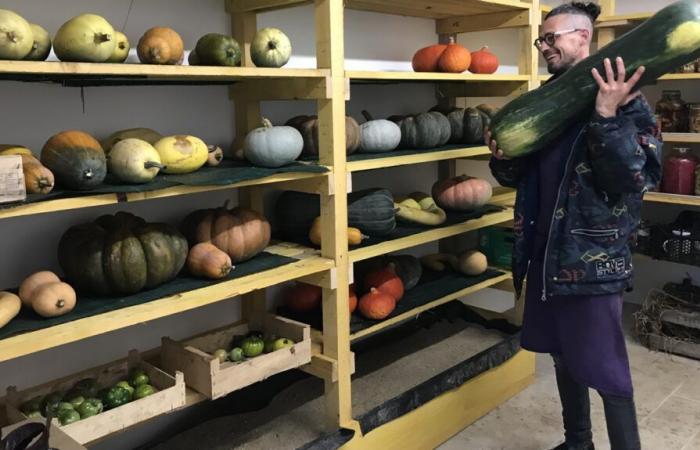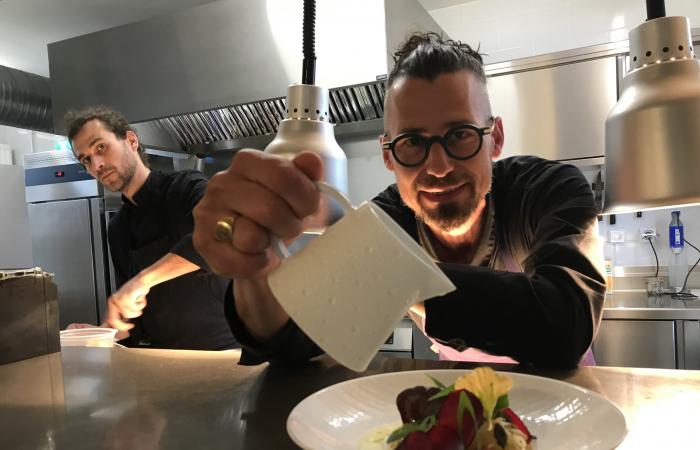Autumn vegetables are making a comeback: pumpkin, turnips and cabbage of all kinds are returning to the shelves. Chef Martin Bolaers enhances seasonal produce at Les Jardiniers restaurant in Ligré. For The New Republic, he gives his cooking advice for autumn vegetables that are far from monotonous.
Revisiting the beet
The chef, who worked at a Michelin-starred restaurant in Luxembourg and at the gourmet restaurant of the royal abbey of Fontevraud (Maine-et-Loire), enjoys cooking frankly. Without artifice. He puts on the plate what the restaurant's vegetable garden offers him: “I like knowing how to grow vegetables, because I then cook them,” he says, crouching in his vegetable garden, a beet in his hand. The most surprising are his tips for cooking this root: raw!
Chioggia beets, pink and white, Albina beets, white, or even the traditional red beet can be eaten raw. The vegetable chef serves them this way: « You have to cut very thin slices, using a mandolin is best,” explains the 43-year-old cook, slicing the red vegetable with a precise gesture. These typical roots of northern cuisine bring sweetness to classic salads.
White and Chioggia beets from the Ligré vegetable garden.
© Photo NR, Charlotte Boutefeu
Squash in the spotlight
Autumn produces its share of squash. In the garden and the restaurant kitchens they all have their place, and the chef cooks them in every way.
Spaghetti squash: as its name suggests, this vegetable can be transformed into pasta. Nothing could be simpler: cook the vegetable for twenty-five minutes in the oven at 180°C covered. First, open it in half and deseed it. Once cooked, all you have to do is enjoy the thin strips which fall apart on their own.
The Hungarian blue squash only has blue skin, its flesh is yellow. It can be cooked as a puree according to the chef who obtained his first green star in the Michelin guide. And with butter, of course.
But be careful, with squash almost sweet in taste, you have to add a little something. A touch of acidity (homemade or artisanal ketchup to maintain the acidity of the tomato, or vinaigrette) to enhance the sweetness of the vegetable. Chef’s tip!
Jerusalem artichoke can also find a place in our recipes: to eat cooked and even raw! A solution « fun » according to the chef to rediscover this vegetable.
Here are some ideas from the chef for simple cuisine, infinitely adaptable depending on the season.
Charlotte Boutefeu
Chef Martin Bolears pours the vinaigrette sauce over the salad.
© Photo NR, Charlotte Boutefeu
A recipe to make at home: squash salad
Recipe idea for a hot and cold salad perfect for this season when temperatures are dropping.
Ingredients :
The squashes:
A giantess from Naples
A Tromba
A spaghetti squash
Other vegetables:
A red beet
Pumpkin seeds (or other seeds that you want)
Other :
Butter (lots of butter)
White wine
Cider vinegar
Ketchup (artisanal or homemade to keep the acidity of the tomatoes)
Cut the trunk of the tromba into strips that are not too thin. Roast them in a pan with butter for five minutes on each side. To book.
Make a puree of giante de Naples. Add 25% brown butter to the steamed squash.
Browned butter: melt the butter in a saucepan until it browns slightly. Remove from the heat, place in a container and filter the butter. Add the filtered part to the squash and mix. To book.
Make spaghetti squash pasta: cut in half and seed the vegetable. Cook covered for twenty-five minutes in the oven at 180°C. Collect the vegetable threads. To book.
Roast pumpkin seeds: place them in the oven for around twenty minutes.
Hot butter vinaigrette: clarify butter then add cider vinegar and salt. Available with white wine.
Dressage :
Place the puree on the plate topped with a fig-infused oil (if you don't have one, substitute with a fruity oil or nothing).
Add the roasted tromba slices and the squash spaghetti around it.
Grate raw beetroot (or slice with a mandolin)
Add ketchup, vinaigrette and roasted seeds.
Enjoy.







